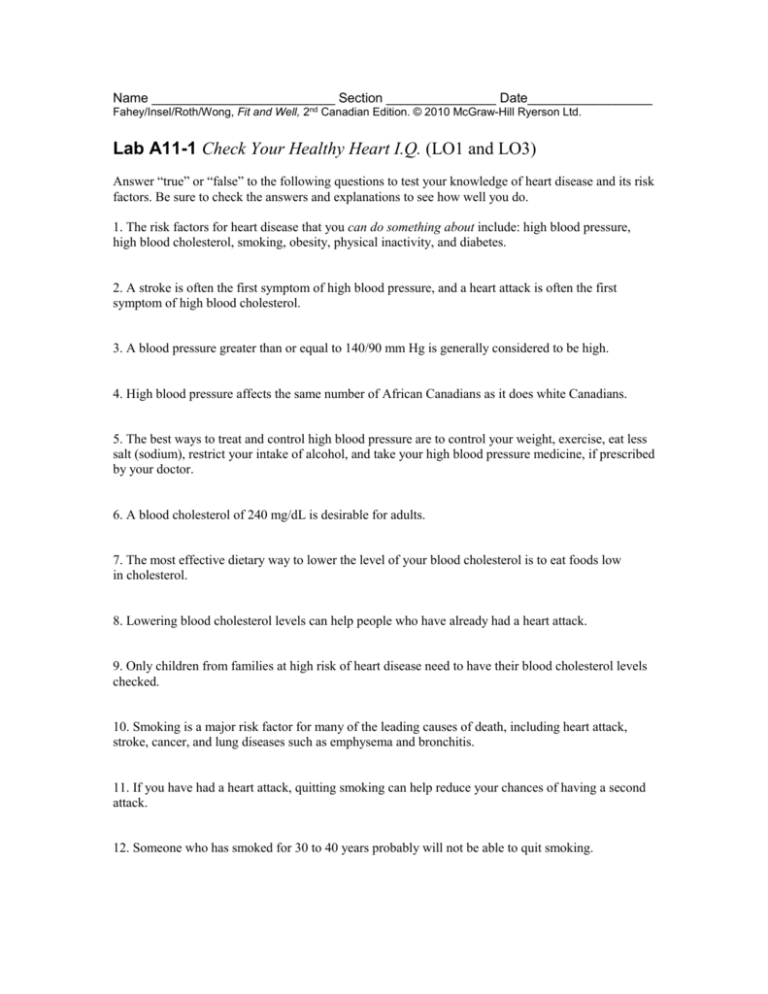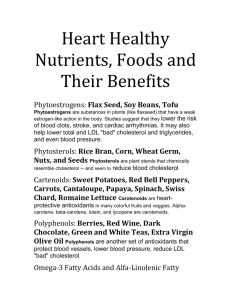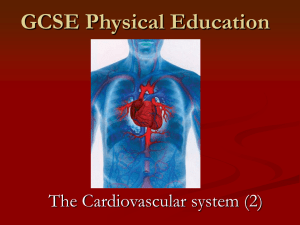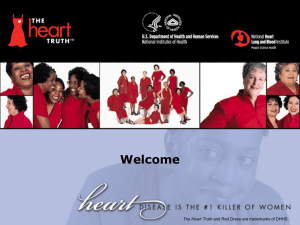Name Section Date - McGraw-Hill
advertisement

Name _________________________ Section _______________ Date_________________ Fahey/Insel/Roth/Wong, Fit and Well, 2nd Canadian Edition. © 2010 McGraw-Hill Ryerson Ltd. Lab A11-1 Check Your Healthy Heart I.Q. (LO1 and LO3) Answer “true” or “false” to the following questions to test your knowledge of heart disease and its risk factors. Be sure to check the answers and explanations to see how well you do. 1 1. The risk factors for heart disease that you can do something about include: high blood pressure, high blood cholesterol, smoking, obesity, physical inactivity, and diabetes. True False 2. A stroke is often the first symptom of high blood pressure, and a heart attack is often the first symptom of high blood cholesterol. True False 3. A blood pressure greater than or equal to 140/90 mm Hg is generally considered to be high. True False 4. High blood pressure affects the same number of African Canadians as it does white Canadians. True False 5. The best ways to treat and control high blood pressure are to control your weight, exercise, eat less salt (sodium), restrict your intake of alcohol, and take your high blood pressure medicine, if prescribed by your doctor. True False 6. A blood cholesterol of 240 mg/dL is desirable for adults. True False 7. The most effective dietary way to lower the level of your blood cholesterol is to eat foods low in cholesterol. True False 8. Lowering blood cholesterol levels can help people who have already had a heart attack. True False 9. Only children from families at high risk of heart disease need to have their blood cholesterol levels checked. True False 10. Smoking is a major risk factor for many of the leading causes of death, including heart attack, stroke, cancer, and lung diseases such as emphysema and bronchitis. True False 11. If you have had a heart attack, quitting smoking can help reduce your chances of having a second attack. True False 12. Someone who has smoked for 30 to 40 years probably will not be able to quit smoking. True False 13. The best way to lose weight is to increase physical activity and eat fewer calories. True False 14. Heart disease is the leading killer of men and women in Canada. True False TF Answers 11. TRUE High blood pressure, smoking, high blood cholesterol, inactivity, obesity, and diabetes are the six most important risk factors for heart disease. On the average, each one doubles your chance of developing heart disease. So, a person who has all six of the risk factors is about 12 times more likely to develop heart disease than someone who has none. Obesity increases the likelihood of developing high blood cholesterol, and high blood pressure and diabetes increase your risk of heart disease. Physical inactivity increases your risk of heart attack. Regular exercise and good nutrition are essential to reducing high blood pressure, high blood cholesterol, and overweight. People who exercise are also more likely to cut down or stop smoking. 12. TRUE A person with high blood pressure or high blood cholesterol may feel fine and look great; there are often no signs that anything is wrong until a stroke or heart attack occurs. To find out if you have high blood pressure or high blood cholesterol, you should be tested by a doctor, nurse, or other health professional. 13. TRUE A blood pressure of 140/90 mm Hg or greater is generally classified as high blood pressure. However, blood pressures that fall below 140/99 mm Hg can sometimes be a problem. If the diastolic pressure, the second or lower number, is between 85 and 89, a person is at an increased risk for heart disease or stroke and should have his/her blood pressure checked at least once a year by a health professional. The higher your blood pressure, the greater your risk of developing heart disease or stroke. Controlling high blood pressure reduces your risk. 14. FALSE High blood pressure is more common in African Canadians than white Canadians and is particularly common among African men. It affects 37 out of every 100 African Canadian men compared to 25 out of every 100 white Canadian men. Also, with aging, high blood pressure is generally more severe among African Canadians than among white Canadians and therefore causes more strokes, heart disease, and kidney failure. 15. TRUE Recent studies show that lifestyle changes can help keep blood pressure levels normal even into advanced age and are important in treating and preventing high blood pressure. Limit high-salt foods, which include many snack foods, such as potato chips, salted pretzels, and salted crackers; processed foods, such as canned soups; and condiments, such as ketchup and soy sauce. Also, it is extremely important to take blood pressure medication, if prescribed by your doctor, to make sure your blood pressure stays under control. 16. FALSE A total blood cholesterol of under 200 mg/dL is desirable and usually puts you at a lower risk for heart disease. A blood cholesterol level of 240 mg/dL or above is high and increases your risk of heart disease. If your cholesterol level is high, your doctor will want to check your levels of LDLcholesterol (“bad” cholesterol) and HDL-cholesterol (“good” cholesterol). A HIGH level of LDL-cholesterol increases your risk for heart disease, as does a LOW level of HDL-cholesterol. A cholesterol level of 200–239 mg/dL is considered borderline-high and usually increases your risk for heart disease. If your cholesterol is borderline-high, you should speak to your doctor to see if additional cholesterol tests are needed. All adults 20 years of age or older should have their blood cholesterol level checked at least once every 5 years. 17. FALSE Reducing the amount of cholesterol in your diet is important; however, eating foods low in saturated and trans fats is the most effective dietary way to lower blood cholesterol levels, along with eating less total fat and cholesterol. Choose low-saturated and trans fat foods, such as grains, fruits, and vegetables; low-fat or skim milk and milk products; lean cuts of meat; fish; and chicken. Trim fat from meat before cooking; bake or broil foods rather than fry; use less fat and oil; and take the skin off chicken and turkey. Reducing overweight will also help lower your level of LDLcholesterol as well as increase your level of HDL-cholesterol. 18. TRUE People who have had one heart attack are at much higher risk for a second attack. Reducing blood cholesterol levels can greatly slow down (and, in some people, even reverse) the buildup of cholesterol and fat in the walls of the arteries and significantly reduce the chances of a second heart attack. 19. TRUE Children from “high risk” families, in which a parent has high blood cholesterol (240 mg/dL or above) or in which a parent or grandparent has had heart disease at an early age (at 55 years of age or younger), should have their cholesterol levels tested. If a child from such a family has a cholesterol level that is high, it should be lowered under medical supervision, primarily with diet, to reduce the risk of developing heart disease as an adult. For most children who are not from high-risk families, the best way to reduce the risk of adult heart disease is to follow a low-saturated-fat, low-cholesterol eating pattern. All children over the age of 2 years and all adults should adopt a heart-healthy eating pattern as a principal way of reducing coronary heart disease. 10. TRUE Heavy smokers are 2 to 4 times more likely to have a heart attack than nonsmokers, and the heart attack death rate among all smokers is 70% greater than that of nonsmokers. Older male smokers are also nearly twice as likely to die from stroke than older men who do not smoke, and these odds are nearly as high for older female smokers. Further, the risk of dying from lung cancer is 22 times higher for male smokers than male nonsmokers and 12 times higher for female smokers than female nonsmokers. Finally, 80% of all deaths from emphysema and bronchitis are directly due to smoking. 11. TRUE One year after quitting, ex-smokers cut their extra risk for heart attack by about half or more, and eventually the risk will return almost to normal in healthy ex-smokers. Even if you have already had a heart attack, you can reduce your chances of a second attack if you quit smoking. Exsmokers can also reduce their risk of stroke and cancer, improve blood flow and lung function, and help stop diseases like emphysema and bronchitis from getting worse. 12. FALSE Older smokers are more likely to succeed at quitting smoking than younger smokers. Quitting helps relieve smoking-related symptoms like shortness of breath, coughing, and chest pain. Many quit to avoid further health problems and take control of their lives. 13. TRUE Weight control is a question of balance. You get calories from the foods you eat. You burn off calories by exercising. Cutting down on calories, especially calories from fat, is key to losing weight. Combining this with a regular physical activity, like walking, cycling, jogging, or swimming, can help not only in losing weight but also in maintaining weight loss. A steady weight loss of 1/2 to 1 pound a week is safe for most adults, and the weight is more likely to stay off over the long run. Losing weight, if you are overweight, may also reduce your blood pressure, lower your LDLcholesterol, and raise your HDL cholesterol. Being physically active and eating fewer calories will also help you control your weight if you quit smoking. 14. TRUE Coronary heart disease is the #1 killer in the Canada. [Source: Adapted from National Heart, Lung, and Blood Institute. Check Your Healthy Heart I.Q. (http://www.nhlbi.nih.gov/health/public/heart/other/hh_iq.htm; retrieved April 27, 2000).]








